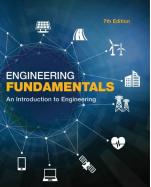Description:
Part I: ENGINEERING. 1. Introduction to the Engineering Profession. Engineering Work Is All Around You. Basic Human Needs, the Changing World Population Age Structure, and Sustainability. Engineering as a Profession. Common Traits of Good Engineers. Engineering Disciplines. Summary. Key Terms. Problems. 2. Preparing for an Engineering Career. Making the Transition from High School to College. Budgeting Your Time. Study Habits and Strategies. Getting Involved with an Engineering Organization. Your Graduation Plan. Summary. Key Terms. Problems. 3. Introduction to Engineering Design. Engineering Design Process. Additional Design Considerations. Teamwork. Project Scheduling and the Task Chart. Engineering Standards and Codes. Water and Air Standards in the United States. Summary. Key Terms. Problems. 4. Engineering Communication. Communication Skills and Presentation of Engineering Work. Basic Steps Involved in the Solution of Engineering Problems. Written Communication. Oral Communication. Graphical Communication. Summary. Key Terms. Problems. 5. Engineering Ethics. Engineering Ethics. The Code of Ethics of the National Society of Professional Engineers. Engineer''s Creed. Academic Dishonesty, Conflict of Interest, Professional Responsibility. Summary. Key Terms. Problems. Part II: ENGINEERING FUNDAMENTALS. 6. Fundamental Dimensions and Systems of Units. Fundamental Dimensions and Units. Systems of Units. Unit Conversion and Dimensional Homogeneity. Significant Digits (Figures). Components and Systems. Physical Laws and Observations. Summary. Key Terms. Problems. 7. Length and Length-Related Variables in Engineering. Length as a Fundamental Dimension. Ratio of Two Lengths--Radians and Strain. Area. Volume. Second Moment of Area. Summary. Key Terms. Problems. 8. Time and Time-Related Variables in Engineering. Time as a Fundamental Dimension. Measurement of Time. Periods and Frequencies. Flow of Traffic. Engineering Variables Involving Length and Time. Summary. Key Terms. Problems. 9. Mass and Mass-Related Variables in Engineering. Mass as a Fundamental Dimension. Density, Specific Weight, Specific Gravity, and Specific Volume. Mass Flow Rate. Mass Moment of Inertia. Momentum and Kinetic Energy. Conservation of Mass. Summary. Key Terms. Problems. 10. Force and Force-Related Variables in Engineering. Force. Newton''s Laws in Mechanics. Moment, Torque--Force Acting at a Distance. Work--Force Acting Over a Distance. Pressure and Stress--Force Acting Over an Area. Linear Impulse--Force Acting Over Time. Summary. Key Terms. Problems. 11. Temperature and Temperature-Related Variables in Engineering. Temperature as a Fundamental Dimension. Temperature Difference and Heat Transfer. Thermal Comfort. Heating Values of Fuels. Degree Days and Energy Estimation. Additional Temperature-Related Material Properties. Summary. Key Terms. Problems. 12. Electric Current and Related Variables in Engineering. Electric Current, Voltage, and Electric Power. Electrical Circuits and Components. Electric Power Sources. Electric Motors. Lighting Systems. Summary. Key Terms. Problems. 13. Energy and Power. Work, Mechanical Energy, and Thermal Energy. Conservation of Energy. Power. Efficiency. Energy Sources, Generation, and Consumption. Summary. Key Terms. Problems. Part III: COMPUTATIONAL ENGINEERING TOOLS. 14. Computational Engineering Tools Electronic Spreadsheets. Microsoft Excel Basics. Excel Functions. Plotting with Excel. Creating a Pivot Table in Excel. Matrix Computation with Excel. An Introduction to Excel''s Visual Basic for Applications. Summary. Key Terms. Problems. 15. Computational Engineering Tools MATLAB. MATLAB Basics. MATLAB Functions, Loop Control, and Conditional Statements. Plotting with MATLAB. Matrix Computations with MATLAB. Symbolic Mathematics with MATLAB. Summary. Key Terms. Problems. 16. Computational Engineering Tools An Introduction to Programming with Python. Computer Programming Process. Python Basics. Python Functions, Loop Control, and Conditional Statement. Plotting with Python. Matrix Computations with NumPy. Summary. Key Terms. Problems. Part IV: ENGINEERING GRAPHICAL COMMUNICATION. 17. Engineering Drawings and Symbols. Mechanical Drawings. Civil, Electrical, and Electronic Drawings. Solid Modeling. Engineering Symbols. Summary. Key Terms. Problems. Part V: ENGINEERING MATERIAL SELECTION. 18. Engineering Materials. Material Selection and Origin. The Properties of Materials. Metals. Concrete. Wood, Plastics, Silicon, Glass, and Composites. Fluid Materials: Air and Water. Municipal and Industrial Waste. Summary. Key Terms. Problems. Part VI: MATHEMATICS, STATISTICS, AND ENGINEERING ECONOMICS. 19. Mathematics in Engineering. Mathematical Symbols and Greek Alphabet. Linear Models. Nonlinear Models. Exponential and Logarithmic Models. Matrix Algebra. Calculus. Differential Equations. Summary. Key Terms. Problems. 20. Probability and Statistics in Engineering. Probability--Basic Ideas. Statistics--Basic Ideas. Frequency Distributions. Measures of Central Tendency and Variation--Mean, Median, and Standard Deviation. Normal Distribution. Summary. Key Terms. Problems. 21. Engineering Economics. Cash Flow Diagrams. Simple and Compound Interest. Future Worth of a Present Amount and Present Worth of a Future Amount. Effective Interest Rate. Present and Future Worth of Series Payment. Interest-Time Factors. Choosing the Best Alternatives--Decision Making. Excel Financial Functions. Summary. Key Terms. Problems. Appendix. Index.
Expand description

Please Wait

